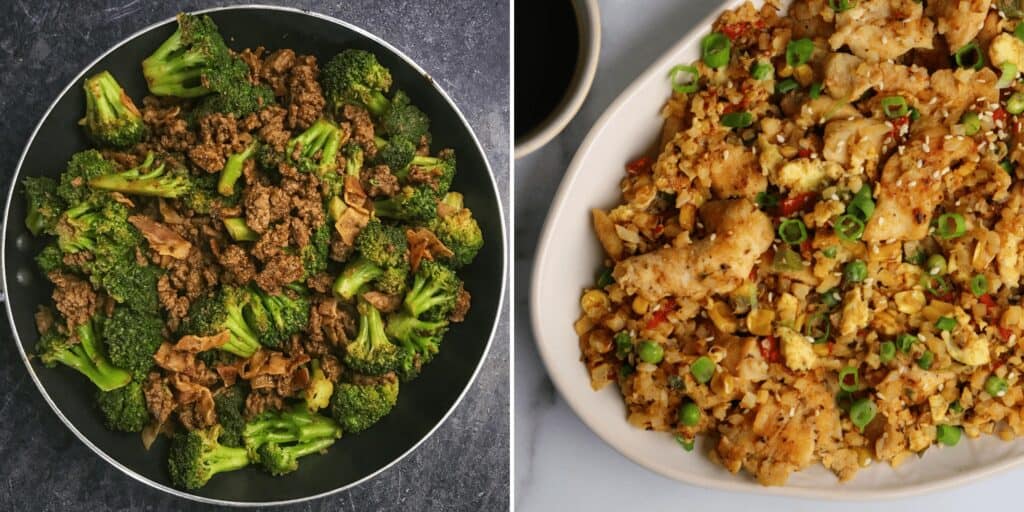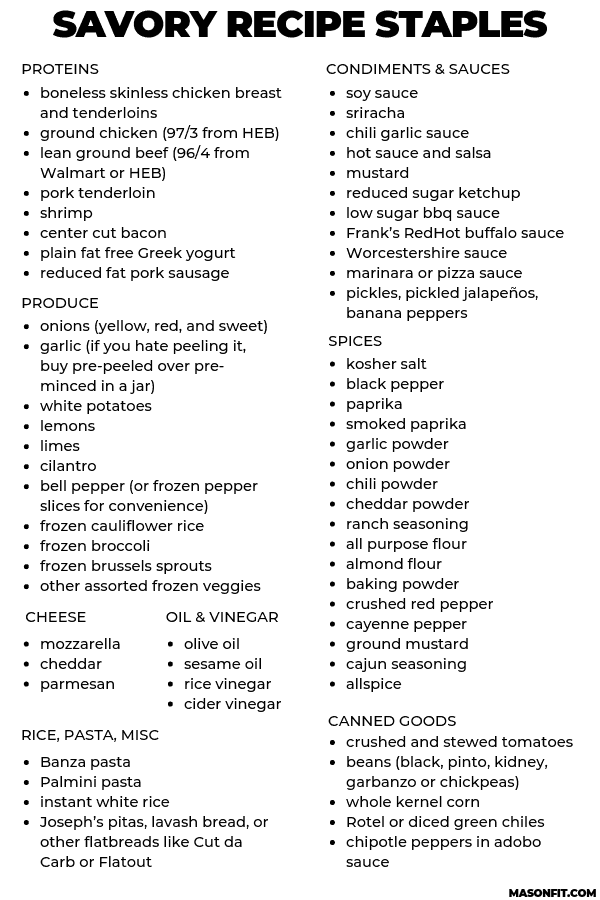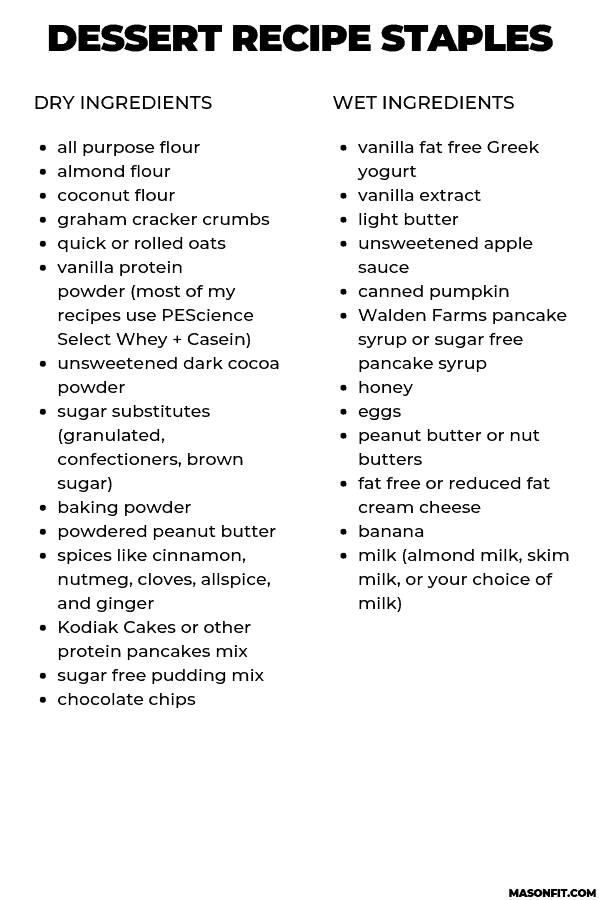My goal with this guide is to give you a detailed list of the things I use most often. If you enjoy making my recipes, you could stock up on all the non-perishable ingredients in this guide and be good to go for 90% of recipes.
The substitutions guide hopefully answers the most commonly asked questions about ingredient modifications. I feel like I could write 10k words and still not cover everything on this topic, so I’ve done my best to keep it concise.
Ingredients Guide Table of Contents:
- Savory Recipe Staples
- Refrigerated Ingredients (proteins, produce, cheese, condiments)
- Pantry Ingredients (spices, oils, rice and pasta, canned goods)
- Dessert Recipe Staples
- Dry Ingredients
- Wet Ingredients
- Substitution Guide
- All Purpose vs Almond vs Coconut Flour
- Other Structural Ingredients (oats, graham cracker crumbs, etc.)
- Fats and Fat Replacements
- Dairy and Egg Substitutes
- Baking with Different Protein Powders
- Sugar Substitutes
- Printable Lists
I’ll continue tweaking this guide as I improve in the kitchen and experiment with more ingredients and substitutes. Feel free to drop a comment with an ingredient question or suggestion. I hope this guide is helpful!
Note: If you’re looking for any niche ingredients on the lists, you can find the specific products I use on my Amazon list.
1. Staple Ingredients for Savory Recipes
Refrigerated Ingredients
Proteins
- boneless skinless chicken breast and tenderloins
- ground chicken (97/3 or 98/2 if available)
- lean ground beef (96/4)
- pork tenderloin
- shrimp
- center cut bacon
- plain fat free Greek yogurt
- reduced fat pork sausage
Note: You can sort recipes by categories like ground beef recipes or chicken recipes on my blog.
Produce
- onions (yellow, red, and sweet)
- garlic (if you hate peeling it, buy pre-peeled over pre-minced in a jar)
- white potatoes
- lemons
- limes
- cilantro
- bell pepper (or frozen pepper slices for convenience)
- frozen cauliflower rice
- frozen broccoli
- frozen brussels sprouts
- other assorted frozen veggies
Note: Frozen vegetables are a great way to eliminate food waste and always have things on hand, especially for out of season ingredients. Contrary to popular opinion, frozen fruits and vegetables are picked at peak ripeness and flash frozen. And it’s so easy to take a bag of broccoli from frozen to something like Sticky Sweet Ground Beef and Broccoli or Chili Garlic Chicken Fried Cauliflower Rice when you can just pop it in the microwave.

Cheese
- mozzarella
- cheddar
- monterey jack
- parmesan
Note: Buy unprocessed cheese when possible and shred or grate it yourself. Processed cheese has emulsifiers and anti-caking agents that make the cheese kinda suck compared to the real deal. Exceptions include reduced fat or fat free cheese. You know you’re sacrificing quality for calories in that case.
Condiments and Sauces
- soy sauce
- sriracha
- gochujang
- chili garlic sauce
- hot sauce
- mustard
- reduced sugar ketchup
- low sugar bbq sauce (I like G Hughes and Stubbs)
- Frank’s RedHot buffalo sauce
- Worcestershire sauce
- salsa
- marinara or pizza sauce
- pickles, pickled jalapeños, banana peppers or pepperoncinis
Note: Most of these ingredients are used both inside recipes and as condiments for finished recipes and everyday meals.
Pantry Ingredients
Spices and Dry Ingredients
Most Frequent
- kosher salt
- black pepper
- paprika
- smoked paprika
- garlic powder
- onion powder
- chili powder
- cheddar powder (dehydrated cheddar cheese to reconstitute for cheese sauces or dry seasoning)
- ranch seasoning
Less Frequent
- all purpose flour
- almond flour
- baking powder
- crushed red pepper
- cayenne pepper
- ground mustard
- cajun seasoning
- allspice
Note: You’ll see some repeats when you get to the baking section. I try to stick to a semi-small wheel house so you don’t run into recipes where you’re missing one spice. That said, it’s great to have all kinds of spices and dried herbs on hand.
Oil and Vinegar
- olive oil
- sesame oil
- chili oil
- rice vinegar
- apple cider vinegar
Note: I could honestly list every type of oil and vinegar here. These are great ingredients for adding tons of flavor in dishes in addition to having utility like coating cast iron or stainless steel skillets and deglazing pans. These four are just the ones I use in recipes most often.
Rice, Pasta, and Miscellaneous
- Banza pasta (or a chickpea pasta)
- Palmini pasta (hearts of palm pasta)
- instant white rice (or your choice of rice)
- Joseph’s pitas, lavash bread, or other flatbreads like Cut da Carb or Flatout
Note: My recipes don’t call for a ton of rice and when they do, frozen cauliflower rice is usually the go-to. However, some of my more popular recipes like the cajun sausage pasta bake, taco pasta bake, and chicken fajita pasta bake use Banza pasta. Palmini is a newer addition I’ve used for things like low carb pasta carbonara that I’m really loving!
Canned Goods
- crushed and stewed tomatoes
- beans (black, pinto, kidney, garbanzo or chickpeas)
- whole kernel corn
- Rotel or diced green chiles
- chipotle peppers in adobo sauce
Note: Unlike frozen veggies, I’d avoid canned vegetables when possible. The ingredients here are some of the exceptions to this and are, in some cases, even better canned.
2. Staple Ingredients for Desserts and Baked Goods
Dry Ingredients
- all purpose flour
- almond flour
- coconut flour
- graham cracker crumbs
- quick or rolled oats
- vanilla protein powder (you can use my affiliate discount code ‘mason’ to save 15% off PEScience products)
- unsweetened dark cocoa powder
- sugar substitutes (I like Swerve – an erythritol based sweetener)
- granulated
- confectioners
- brown sugar
- baking powder
- powdered peanut butter
- spices like cinnamon, nutmeg, cloves, allspice, and ginger
- Kodiak Cakes or other protein pancakes mix
- sugar free pudding mix
- chocolate chips
Wet Ingredients
- vanilla fat free Greek yogurt
- light butter (I use Land O’ Lakes light butter with canola)
- unsweetened apple sauce
- canned pumpkin
- vanilla extract
- Walden Farms pancake syrup or sugar free pancake syrup
- honey
- eggs
- peanut butter or nut butters
- fat free or reduced fat cream cheese (I find fat free at Kroger, Walmart, and HEB)
- banana
- milk (almond milk, skim milk, or your choice of milk)
3. How to Make Ingredient Substitutions
What’s the difference between almond flour, all purpose flour, and coconut flour?
Substituting one flour for another is tricky. There’s a lot of sciency stuff in play with baked goods, so just expect some trial and error. I’ll briefly run you through my best tips.
Coconut flour is a mythical ingredient with unique properties. It’s super absorbent and nearly always takes some tinkering to get right when substituting. It’s easy to end up with baked goods that are dry as a bone with coconut flour.
This is why I use coconut flour the least out of the trio and use almond flour as my preferred swap for all purpose flour when you need a low carb or gluten free substitute. However, it is worth touching on their macronutrient differences:
- 1/4 C Almond Flour = 170 calories, 6g protein, 5g carbs, 15g fat
- 1/4 C All Purpose Flour = 110 calories, 3g protein, 22g carbs, .5g fat
- 1/4 C Coconut Flour* = 120 calories, 4g protein, 16g carbs, 4g fat
*I recommend a 1:2 or 1:3 ratio when swapping all purpose for coconut flour. So, a more accurate comparison might be 2 tablespoons of coconut flour (60 calories).
The takeaways: If you need a gluten free alternative for all purpose, I’d go with almond flour. On the flip side, if a recipe calls for almond flour and you need a lower calorie option, use all purpose flour. And if you’d like a lower calorie option altogether, try swapping coconut flour for 1/3 or 1/2 the all purpose or almond flour.
Graham Cracker Crumbs, Oats, Protein Powder, Cake Mixes, and Other Dry Ingredients
Something to keep in mind is the purpose of “structural” ingredients. All the flours and the ingredients above can be somewhat interchanged. You might need to tweak the amounts slightly and experiment, but they’ll all get the job done.
This can be a great way to work around dietary needs or ingredient shortages as well as modify nutritional breakdowns of recipes.
Need a bit more protein and fewer carbs? You might be able to swap a carb heavy structural ingredient with a bit more protein powder.
Fat Replacements for Baked Goods
Nobody likes tough, dry, or granular baked goods. So it’s important to know your lower calorie fat substitutes. Similar to flour swaps, these may take a bit of tinkering with substitution amounts.
- Canned Pumpkin – quite possibly the best fat replacement due to its mild flavor, moisture, and calorie count
- Unsweetened Apple Sauce – substitutes 1:1 for butter in recipes but has the flavor of apples so if you don’t have stronger flavors, use half butter and half apple sauce or partially mix with pumpkin
- Fat Free Greek Yogurt & Cream Cheese – Greek yogurt is magical and can work in similar ways to oil in baked goods. And cream cheese mixed with sweetener adds creaminess and moisture to anything.
- Mashed Banana – similar to apple sauce but with an even stronger flavor
- Light Butter – 50% fewer calories than real butter and still gets the job done
- Chocolate Chips & Low Cal Milk – 1 Tbsp (14g) of chocolate chips melted with 1-2 Tbsp of milk only contains 80-90 calories but provides rich, moist chocolate goodness to a recipe
- Nut Butters – technically a fat, but I like to recommend them as a potential substitute for butter (or any fat) in recipes, similar to melted chocolate chips
- PB2 Powdered Peanut Butter – mix with water for a faux peanut butter
- Walden Farms Pancake Syrup – technically this is more of a sticky sweetener, but the consistency lends itself really well to keep high protein baked goods moist
Some of these work better than others for swapping. Powdered peanut butter, for instance, will never fully replace peanut butter due to the lack of fat. It will provide the flavor but will lack in function.
However, adding something like pumpkin in addition to peanut butter or even powdered peanut butter will mimic the function of full fat peanut butter to a certain degree without adding the extra calories.
Dairy and Egg Substitutes
I’m no expert in this area, but I’ll do my best to provide an idea or two.
Butter and Eggs
- use the substitutions above like apple sauce, pumpkin, banana, avocado, etc.
- aquafaba from canned chickpeas can be used as egg whites
- flax eggs
Yogurt
- bean or silken tofu puree works well for adding creaminess to savory recipes
- coconut milk and other plant-based milk can be turned into creams and yogurts
- mixing a plant-based protein powder with non-dairy milk and a thickener like arrowroot, corn starch, etc. can mirror Greek yogurt
- use vegan yogurt
Cheese
- nutritional yeast (tastes a bit like parmesan – my air fryer potato chips have a dairy free cheese version)
- cashews and soaked nuts
- chickpea puree
- use vegan cheese products
Baking with Different Protein Powders
Just don’t.
Kidding. Kind of.
Protein powders are like snowflakes or thumbprints—none are identical. This makes using a different protein powder than the recipe calls for inherently risky. If at all possible, use whatever protein powder a recipe calls for.
For the risk takers and rump shakers, here are my top tips for using different protein powders:
- Match the type of protein: whey concentrate, whey and casein blend, pure casein, soy protein isolate, etc.
- Match gram for gram, not scoop for scoop. You’ll need a food scale for successful baking, anyway. (If a recipe doesn’t provide grams, use a real recipe. Kidding again. Kind of.)
- Start small instead of wasting ingredients. If you can scale a recipe down by half or 1/4th, do that to see if your protein powder will be a good substitute or what adjustments need to be made.
Troubleshooting
If a protein powder recipe is dry or tough, you have a few options:
- Decrease the amount of protein powder used and change nothing else.
- Increase the amount of structural ingredients like flour and decrease the protein powder. (Example: 1/4 cup of flour and 2 scoops of protein becomes 1/3 cup of flour and 1.5 scoops of protein.)
- Add moisture via fat, fat replacements, milk/liquid, etc.
- Try a shorter bake time. Proteins become tough with too much heat exposure. If a recipe doesn’t have food safety concerns, under baking is always a good idea.
And if worst comes to worst, just bite the bullet and get some of the protein powder the recipe calls for. I do my best to stay consistent and I’d say 75% of protein powder recipes on my blog call for the same protein (PEScience).
Sugar Substitutes
As you saw in the dry ingredients section above, the trio of Swerve sweeteners are my go-to sugar substitutes. Here’s a handful of ideas for swaps:
- Granulated Swerve: any sugar substitute that swaps 1:1 with sugar (monkfruit, stevia baking blends, sucralose or Splenda)
- Swerve Confectioners (powdered sugar): blend a granulated sugar substitute with some type of thickener like arrowroot powder, corn starch, or xanthan gum (or even a bit of protein powder)
- Swerve Brown (brown sugar): Sugar free pancake syrups work in recipes like my Carolina BBQ Crockpot Chicken where consistency doesn’t matter all that much. In a recipe like Wingstop fries where you want to preserve the brown sugar crystals, a bit of granulated sugar substitute mixed with molasses or honey may do the trick.
With any of these sweeteners, keep in mind the amount the recipe calls for. If a recipe calls for 1-2 tablespoons, using the real thing will only set you back 50-100 calories. If that’s in a recipe that makes 10+ servings, that’s 5-10 calories per serving. Not a huge deal!
That’s a Wrap for Now
Don’t forget to let me know what ingredient substitution questions or suggestions you have. Leave a comment or join my free Facebook group and share it there. There’s a great chance the members there can answer it before I can!
You can also save the images below for an easy reference sheet.
4. Printable Lists


